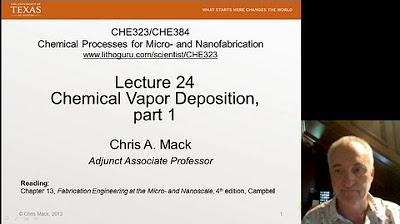Chemical Vapour Deposition (CVD)
Summary
TLDRIn this informative video, Dmitri and Konstantin guide viewers through the process of creating nanomaterials using chemical vapor deposition (CVD). The procedure begins with the preparation of a powder mixture, which is carefully transferred into a furnace set to high temperatures. Through the reaction of gases like ammonia and boric acid, boron nitride nanostructures are formed on silicon wafers. The process, which lasts about 10 hours, is demonstrated step-by-step, showcasing the intricate setup of the furnace, gas flow, and careful monitoring. The final product reveals the successful growth of nanostructured coatings on the wafers.
Takeaways
- 😀 Dmitri introduces the lab and the procedure of making nanomaterials using chemical vapor deposition (CVD).
- 😀 The electrical furnace in the lab can reach temperatures of up to 1700°C, essential for the CVD process.
- 😀 Gas pipelines are used in the lab, with different gases depending on the type of material being synthesized.
- 😀 A gas sensing system is installed to detect dangerous gas leaks and shut down the process automatically.
- 😀 The test conducted the previous day produced boron nitride nanomaterials, indicated by a change in the color of the silicon wafer.
- 😀 Konstantin demonstrates the preparation of the powder mixture, which includes magnesium oxide, boron, and boric acid.
- 😀 The powder is measured and mixed in a glass container, then carefully transferred to a ceramic boat for processing.
- 😀 Silicon wafers are placed in the furnace's high-temperature zone, where nanostructures will grow during the process.
- 😀 After transferring the powder and substrate to the furnace, the system is sealed, and a vacuum pump is used to create a vacuum inside.
- 😀 Gases such as argon and ammonia are introduced into the furnace to maintain the necessary conditions for the CVD reaction.
- 😀 The reaction starts when the furnace temperature reaches 1300°C, leading to the creation of boron nitride nanostructures on the silicon substrate.
- 😀 After the reaction, the sample is cooled down, and the powder changes color, indicating successful synthesis of the nanomaterials.
- 😀 Konstantin explains how temperature gradients in the furnace cause different intensities in the reaction, which affect the color change in the samples.
- 😀 The resulting silicon wafer shows significant changes in color, confirming the formation of nanostructured coatings on its surface.
- 😀 The entire CVD synthesis procedure takes about 10 hours, including heating, reaction time, and cooling down.
Q & A
What is the main purpose of the chemical vapor deposition (CVD) process demonstrated in the video?
-The purpose of the CVD process demonstrated is to create nanomaterials, specifically boron nitride, by using a chemical reaction inside a furnace with various gases, as shown in the experiment.
What is the role of the electrical furnace in the process?
-The electrical furnace is the key component in the system, as it can be heated up to 1700°C, which is crucial for facilitating the chemical reactions required to produce nanomaterials.
Why is a gas sensing system used in the laboratory setup?
-The gas sensing system is used to detect any gas leaks. If a leak occurs, the system automatically shuts down to prevent any dangerous situations.
What materials are used to prepare the powder mixture for the synthesis?
-The powder mixture is made using 0.5 grams of magnesium oxide, 9 grams of boron, and 2 grams of boric acid.
What is the importance of the silicon wafer in the CVD process?
-The silicon wafer acts as the substrate where the nanostructures will grow. It is placed in the furnace to allow for the deposition of the nanomaterials during the reaction process.
How is the powder mixture placed inside the furnace during the experiment?
-The powder mixture is carefully placed in the furnace's low-temperature zone using a stick marked with centimeters, ensuring it stays in the appropriate area and doesn't spill.
What is the function of the thermo radiation shield in the furnace?
-The thermo radiation shield prevents the end seals of the furnace from overheating, protecting the system during the high-temperature process.
Why is the vacuum pump used in the experiment, and how is it operated?
-The vacuum pump is used to remove air from the furnace, creating a controlled environment. It is turned on slowly to avoid spilling the powder, and the pressure is gradually lowered before proceeding.
What gases are used in the CVD process, and why are they important?
-Argon and ammonia gases are used. Argon is used to create a protective atmosphere inside the furnace, while ammonia reacts with the boron compound to form boron nitride nanostructures.
How is the temperature controlled during the synthesis process, and what is its significance?
-The furnace is gradually heated to 1300°C, where the reaction begins. Maintaining precise temperature control is crucial to ensuring the successful formation of the boron nitride nanostructures.
Outlines

This section is available to paid users only. Please upgrade to access this part.
Upgrade NowMindmap

This section is available to paid users only. Please upgrade to access this part.
Upgrade NowKeywords

This section is available to paid users only. Please upgrade to access this part.
Upgrade NowHighlights

This section is available to paid users only. Please upgrade to access this part.
Upgrade NowTranscripts

This section is available to paid users only. Please upgrade to access this part.
Upgrade Now5.0 / 5 (0 votes)





